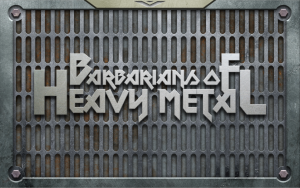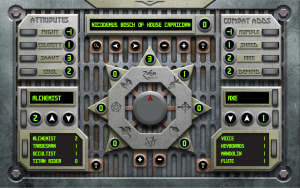Background: 1982
Nineteen Eighty-Two was a watershed year for RPG releases. Among the noteworthy games that saw print that year were the Basic Roleplaying Worlds of Wonder box set, Bunnies & Burrows, Daredevils, GangBusters and Star Frontiers, the original FASA Star Trek RPG, and the nicely combined into one package Traveller as found in The Traveller Book. That’s a mighty fine vintage right there, and I’m proud to count a number of those gems in my collection to this day.
Not among the noteworthy releases, but still released in 1982 was a little game called Droids: A Cybernetic Role-Playing Game written by Neil Patrick Moore and published by Integral Games out of Arlington, Texas. I never could get my hands on this slim little book back in the day, despite seeing ads for it in Space Gamer (among other mags of the time). Oh, I tried to get it. I asked constantly at Lone Star Comics. I even begged my mom to drive me to some other store on the outskirts of Dallas who claimed to have a copy. When they didn’t, I gave them a few bucks to special order it, but it never materialized.
My impression of the game from the advertising was that it was set in a world where mankind had managed to destroy itself in a massive nuclear war that these machines had managed to survive (the physics of the electromagnetic pulse didn’t really register with my young brain). So here was the nightmare of every cold war kid made somehow palatable by the continuation of “life” on earth in the form of these sentient robots who were still out there trying to survive.
This impression held through the demo game I either played in at Origins ’84. My memories of the session are sketchy at best, but I think we were out in a desert somewhere and descending on a service depot to try to get more ammunition or something. I do know that the feeling I got from the game was akin to the feeling I got watching the video for Robert Plant’s Big Log – isolation, loneliness, and ennui:
http://www.youtube.com/watch?v=XZQL22xOmUM
Despite living in essentially the same city as the producers and having been in close proximity to the game at the big con, I still never managed to get a copy. Not long after that I dropped most of my RPG habit in the name of being a rock ‘n’ roll bassist and completely forgot about Droids altogether.
The Game In Hand: 2010
Nearly thirty years later, after having wandered my way into and out of RPGs as a hobby more than once (and still playing bass), my wife asked back-into-RPGs me what I wanted for my birthday. I had pretty much everything I needed or wanted in life, but there was something nagging at the back of my mind. Something about… robots? No, not robots. Some other word. Mechs? No. Just ‘bots? No. Droids! That was it. And it turned out that Noble Knight had a copy in their fabulous vaults of out of print games, so she ordered it for me. I really do love that woman.
I don’t know what I was expecting, physically, but I was a little surprised to discover that the Droids book was a slim 80 page digest (5½” X 8½”). I guess it had loomed large enough in my memory that I was looking for a huge, dusty tome or something. But that’s definitely not what this game is. Physically it fits right in with the Traveller little black books, which is probably appropriate somehow.
The Game Itself
Yeah, yeah. You didn’t come here to read about my childhood or how cool my wife is, I know. You want to know something about this game you’ve (probably) never heard of. Well, let’s get to it, then.
Introduction
The game opens with a bit of background, explaining that man made droid and droid overthrew man because organic life is squishy and inferior. Hmm, that’s not what I’d pictured at all. Weird. Oh well, it’s an interesting concept. Somebody ought to make a movie where humanity is overthrown by its mechanical creations… Anyway, apparently the droids weren’t content to be rid of the humans. Nope, their own internecine wars raged on until “the machine wars left no victory, and threw the world into total anarchy with every droid left to fend for itself.” Mecha-Atlas shrugged, I guess.
After the history lesson, we’re advised to get our manipulating units on some notebook paper, graph paper, and “a pair of differently colored twenty-sided percentile dice,” the rolling of which is explained immediately. We’re also given a quick explanation of the metric system, complete with rough conversion values. That’s handy.
Droid Construction
With that bit of setup out of the way, it’s time to start building droids. To build a droid you need to know that you’ve got 20 Construction Points (CP). CO represent the cost of each unit that is used to build a droid. Apparently some units will be listed that are completely unaffordable and “must be sought out once play begins.” Now we have an idea of what droids consider treasure.
Each unit also has both a Power Consumption (PC) stat and number of Bulk Points (BP). PC ranges from 0 to 6 for most units, but can go quite high (topping out in the rules at 40 for the Omegatron/Dragon Ray laser). It’s worth noting that PC can be zero, but that just means there’s no appreciable draw from a power source, even though the unit must be connected to one. BP indicate a unit’s size and weight, with 1 BP representing approximately an area of 0.1 m³ and a mass of 12 kg.
Droids have brains, too. That’s where the droid’s “personality and decision making circuitry” reside. These are metal cubes 10 cm on a side which have effectively 0 BP. A brain must be attached to a power source, though they can survive for up to 24 hours on internal battery backup. Longer than that w/o power and it’s adios, droid. Droid brains may be located and removed on any droid which is under 10 BP in size. So if you blow a bunch of units off of a big droid, you can pick its brain…
Building a droid is pretty much an exercise in menu selection. Pick some transport units (wheels, legs, VTOL propellers, hydrofoils, helium balloons, tunneling drills, and so on) first, or else you’ll be stuck in one spot. Picks some manipulative units next so you can interact with the world. Choose some power units to provide the juice (power units have negative PC values rather than providing a budget of PC points, FYI).
Pick up a viewing unit or two (cameras, night scopes, etc.), some sensor units (sound sensors, radar and such), and communications units (light communicators are blinking rows of lights, voice communicators let you talk & include listening, radio transmitters let you pump up the volume, etc.) so you’re not Tommy. Be sure to snag some interfaces accessing data and modules for storing programs and data, too.
Once all of the above is handled, it’s time to talk weapons. Because, as you’ll recall, it’s every droid for itself and you’re going to need to resort to violence. See, as a droid you’re superior to those pesky humans who created you, but apparently they built their propensity for conflict into you. Or maybe they released a virus in the waning days of their existence that was meant to cause the droids to fight amongst themselves or something. Who knows? Anyway, weapons.
The armaments available to the discerning droid in whatever year this is include (but are not limited to) machine guns, gauss guns, cannon, rocket launchers, lasers (alpha, beta, gamma and the aforementioned omega ray varieties), ion and plasma cannons, and, of course, mines and flamethrowers and such. Just make sure you load up on the appropriate ammo, too. Happiness may be a warm gun, but and empty gun no bang bang, shoot shoot.
Of course, if you can have weapons the other droids probably have them, too. Thus, you’ll probably be interested in picking up some general purpose deflector screens or some armor to protect specific units on your droid. Screens protect a set value vs. either projectile or energy weapons. Armor is ablative and protects against either weapon category.
Now that you’re finished out your droi… But wait! There’s more. What kind of game would this be if it didn’t offer up a number of “Miscellaneous Units” to fill up whatever space you might have left on your droid? A terrible one, that’s what kind. So if by some chance you still have CP available (and have enough PC to spare) why not bolt on a spotlight? Or maybe an ECM unit? Or perhaps some waterproofing? Or maybe a power cord to let you transfer power to another willing droid? Ginsu knives are not on this list, but they should be.
Now that you’re actually done building your droid, the book encourages you to give it a name. And since “there are an infinite number of names ranging form random combinations of letters and numbers to various computer and industrial names” you really shouldn’t have a problem coming up with something. Helpful examples include CABLE, GR9, VIDEO III, and CRT.
We close out the droid creation chapter with 8 hints to help you with building your droid:
- Have a manipulative unit. Without one you cannot effect repairs and will die. Have more than one, really, and armor them.
- Have a viewing unit. Without one you cannot shoot, repair, or even flee. Make sure it’s armored.
- Have ample power. Don’t expect to have full power at all times. Armor your power sources.
- Have a communication unit that can be understood by the other droids in your party. No one likes the illiterate half-orc who doesn’t speak common, after all.
- Don’t skimp on ammo. You need bullets to survive.
- Expect your armor to be destroyed. Have plenty or prepare to scavenge.
- Avoid being vulnerable at night. Don’t depend exclusively on solar cells and have some kind of night vision in the party.
- Balance is everything. Avoid specialization that will cripple you if “you become detached from the group, expelled, or if an essential member becomes heavily damaged.” Good advice for any game that isn’t too focused on niche protection, really. Plus, if you’re too specialized and are expelled from the group, you’ll never survive long enough to make the rue the day they cast you out.
It might have been helpful if these had come before the big listing of units. But hey. At least they’re here at all. Seriously. This kind of this would be helpful in a lot of games that have you constructing characters from point pools. Especially back in the day, when 12 year old kids were just supposed to have a complete understanding of the game developer’s thought processes.
Movement
I’m not going to dwell on these nearly as much, because they’re not nearly as interesting as droid construction. The bottom line is that there are rules for movement, including speeds for the various propulsion units, percent chances for transport units to break down (hint, avoid swamps if you’re not airborne or waterproofed), and crash landings. It tough out there for a droid.
Combat
Combat in Droids takes place in six second rounds comprised of three phases: Initiative, Combat Movement, and Fire Resolution.
Initiative, which is rolled only once per combat, is determined by a d% roll plus modifiers for additional viewing units and sensors. And if you’re lucky enough to have exceeded an opponent’s initiative by 75 or more, you’ve achieved surprise in the first round and can’t be attacked by that opponent.
Combat Movement is about what one would expect, with adjustments to attack values (q.v.) depending on the mode and direction of movement.
Fire Resolution takes into account range and aiming. Then hit determination, hit location, and damage resolution are handled.
An attack has a percent chance to hit based on a table similar to BRP’s resistance table, where the Attack Value of the weapon is compared against the (total) Bulk Points, thus bigger targets are easier to hit. Certain weapon types can also be aimed, in which case you compare the AV vs. the total BP and the specific unit’s BP to get two numbers, both of which are the targets of a single roll. Beat the lower number and you’ve hit the specific unit. Miss that but beat the higher number and you’ve at least hit the enemy droid. It’s kinda like how the Martial Arts skill works in BRP.
Random hit location is determined by rolling against a table which tells you the BP of the unit hit. Yep, you determine that a unit with (rolls) 7 BP is hit. If there’s no unit with that number of BP, the damage is applied to the unit with the closest BP value. If two or more units have the determined BP, the victim gets to choose which unit was damaged.
The amount of damage done by a hit is determined by a d10 roll against a chart for the specific weapon. These charts give the actual damage value, which ranges from 1 all the way up to 48 for the dreaded Matter Disruptor.
Ramming and Falling are covered in this section as well, but time is short and this piece is long. So let’s agree not to worry about those for now.
Creation
The bulk of the remaining 25 pages of Droids focuses on referring the game (and yes, Referee is the official term, not Droid Master or CPU or something inane). Three sample NPC droids are provided (PEACE, a 25 CP sniper droid; MULTIPLEX, a 35 CP night scavenger; and MACRON, a 50 CP powerhouse), as are some nifty tables for rolling up random droids.
Some coverage is given to Robots, which “are machines that have a command module as their sole means of decision making. They cannot break away from this direction, as they have no brain of their own.” So basically mooks.
This section also introduces Experimental Units and MEga Units (aka magic items). These are both concepts that are more open to individual referee interpretation, though some guidelines are given.
We close out the Creation section with tidbits about organized droid societies, weather, encounter tables, a sketch of a sample adventure, and an example of play. There’s also an end note that suggests looking to science fiction books, movies and magazines for ideas and inspiration. And, at the end, the promise of “scenarios and additional books which may be used in conjunction with Droids to expand and supplement the game as a whole.” Alas, the world apparently had different plans.
Critical Reaction
I just wanted to note that there were (according to the RPGNet Game Index listing for Droids) two reviews from 1983. The Space Gamer #64 (“fails as an RPG”) and Different Worlds #31 (“If you like hack-and-slash … [or] need some robot design rules”). I’m not aware of any other reviews.
I get what these snippits are saying, even if I think they might be too harsh. As presented Droids is definitely pretty barebones. And it focuses very tightly on combat. “Character growth” basically boils down to adding modules scavenged from other sources (including your “kills”) to your droid, making you actually grow in the process. But still, the system is kinda neat and my own brain still dances little apocalyptic doomsday machines after the holocaust jitterbugs when I think about the setting (such as it is) that Droids delivers. One could take this core and make something truly unique out of it, I believe. So personally I wouldn’t call it a failure so much as a good start.
Availability: Scarce!
Droids: A Cybernetic Role-Playing Game is no easier to get your hands on today than it was when I was trying to snag a copy thirty years ago. NobleKnight is probably your best hope, and they haven’t had a copy in stock since 2010 (I’m pretty sure that was the copy I now hold in my hands). I’ve never seen it anywhere else, in print or PDF. But there have to be other copies out there somewhere.
All The Obsolete Simulations Roundup Posts
For your reading pleasure, consider checking out these other participants in the Obsolete Simulations Roundup:

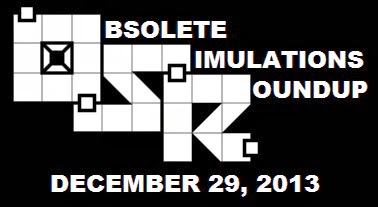
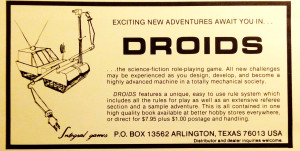

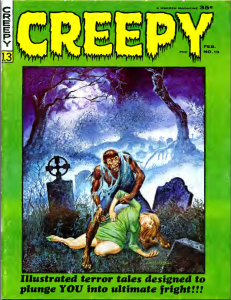 A whole lot of Warren Publishing “not comics” (and therefore not subject to the old CCA Code) are available online at
A whole lot of Warren Publishing “not comics” (and therefore not subject to the old CCA Code) are available online at 